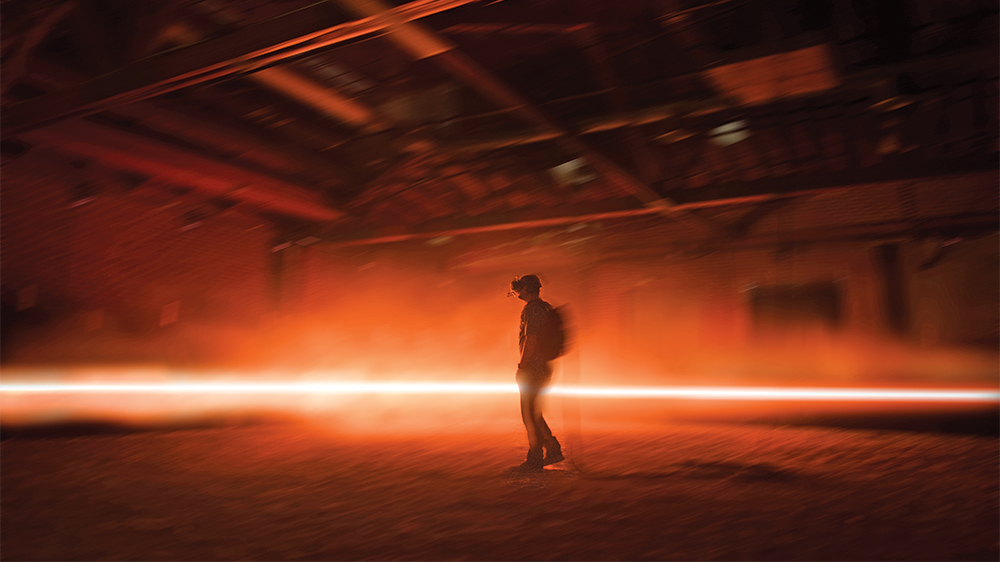Content warning: Graphic violence.
Dubbed a semi-fictionalized ethnography by director Alejandro Iñárritu, CARNE y ARENA, or Flesh and Sand, is a VR exhibition that immerses participants into the lives of undocumented immigrants in the United States. For 15 harrowing minutes, CARNE y ARENA takes participants across the U.S.-Mexico border, hounded by sirens, searchlights, and the desert wind. But the exhibition—on display at Arsenal Contemporary Art Montreal, a gallery housed in a former Lachine Canal shipyard—is not so much about border crossings as it is about what is left behind: Families that could not make it, shoes piled in detention rooms, and footprints in the sand.
The exhibition is divided into two parts. The first is an immersive seven-minute film experience where participants don headphones, a loaded backpack, and a VR headset. Accompanied by a group of 10 virtual immigrants, participants walk barefoot through a room filled with sand to simulate a desert. The threat of being caught by U.S. authorities is ever-present as one crosses the desert: At one point I ran—trying to find virtual cover from border patrol—into a not-so-virtual wall. All the gestures, dialogue, and character models are based on real stories with details cultivated from hundreds of interviews with immigrants. As Iñárritu says, the film is a slice of their nightmare.
The second part of the exhibit begins once participants exit the “desert,” sans headset, into a dark hallway filled with 10 private viewing boxes, each containing a screen situated in a private alcove. Each screen plays a video profile of an immigrant as their stories unfold in text—from the trauma of being thrown into a freezing cell at the border, to the disorientation of a life in America marked by hope, fear, and sacrifice. During each video vignette, the camera shots widen almost imperceptibly to give a fuller picture of the people that risk being forgotten: Luis, who crossed the border at age nine, and years later was the first undocumented immigrant to graduate from UCLA Law School under the DACA policy; Lina, a maid from Guatemala, who had to work, wait, and pray for 20 years before seeing her daughter again. These may very well be the people you encounter in everyday life.
Once flung from the 360° immersion of a simulated desert trek, walking through the exhibit and engaging with each virtual person face-to-face feels like a personal encounter with each of their stories, down to the last haunting detail. From the helpless sounds of someone dying of heat exhaustion, to refugees packed like sardines into train cars or trailers with barely enough space to breathe, the exhibit invites participants to view each vignette individually. Together, they evoke a sense of compassion that is much more complex because it is cumulative. If the screens were displayed regularly—say, in horizontal Zoom grid fashion—participants would be liable to walking by them without absorbing their content. Through frantic immersion and slow intensity—the dizzying technical experiment and the intimate portrait that follows—Iñárritu’s project succeeds in turning the numbing statistics of immigration into real, human stories.
“VR is all that cinema is not, and vice versa; the frame is gone and the two-dimensional limits are dissolved,” reads Iñárritu’s artist statement, which touches on other binaries like spectator and participant, U.S. and T.H.E.M. Formal innovations aside, there is something uncanny about taking part in this VR exhibit when the entire world has been coated in an unreal sheen.
“Virtually present, physically invisible” has been CARNE y ARENA’s tagline since its 2017 Cannes premiere. Four years later, the phrase still sticks with you for many reasons, as you walk through Griffintown—with shoes on—after the exhibit.
CARNE y ARENA, co-produced and optimized for international touring by PHI Studio, is running at Arsenal Contemporary Art Montreal. Tickets are sold out until June 20, but extra dates have been added up to July 11.








